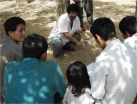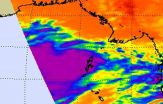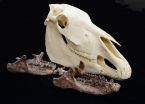(Press-News.org) WASHINGTON, DC – October 8, 2014 - Elephants are among the most intelligent non-humans, arguably on par with chimps, but both African and Asian elephants—separate species—are endangered. In 1995, 16-month old Kumari, the first Asian elephant born at the National Zoo in Washington, DC, died of a then-mysterious illness. In 1999, Gary Hayward of Johns Hopkins University and collaborators published their results identifying a novel herpesvirus, EEHV1 as the cause of Kumari's sudden death. They now show that severe cases like this one are caused by viruses that normally infect the species, rather than by viruses that have jumped from African elephants, which was their original hypothesis. Hayward's latest research appears ahead of print in two concurrently published papers in the Journal of Virology.
At the time of Kumari's death, anti-zoo activists seized on the situation to call for abandoning all efforts to breed Asian elephants in zoos, as they claimed that zoos were spreading the deadly herpesvirus, says Hayward. Contrary to that, in the current research, "We showed that whereas some identical herpesvirus strains infected both healthy and diseased animals concurrently at particular facilities, the majority were different strains, and there has not been a single proven case of the same strain occurring at any two different facilities," says Hayward. "Therefore, the viruses have not spread between zoos, and the sources of the viruses were most likely wild-born elephant herdmates. In fact, we also found the same disease in several Asian range countries, including in orphans and wild calves, and showed that the EEHV1 strains in India displayed the same genetic diversity as those in Western zoos."
The papers also provide substantial data to support the hypothesis that the EEHV collectively represent a new, fourth major branch of the herpesvirus family, the proposed deltaherpesvirus subfamily (Deltaherpesvirinae), says Philip Pellett of Wayne State University, Detroit, who wrote an invited Commentary which accompanied Hayward's papers. "Given that the three other branches were recognized over 30 years ago, establishment of a new subfamily would a big deal."
Pellett adds that "Further scientific significance arises from the discovery of 12 new herpesviruses and identification of some new wrinkles in our understanding of herpesvirus diversity and evolution."
In these studies, the investigators performed extensive DNA fingerprinting of the genetic signatures of all the known EEHV cases, as well as samples of EEHV virus that were obtained from wild Asian and African elephants, says Hayward. In the process, they identified seven different species of EEHVs and multiple different chimeric subtypes and strains of each.
"Because these viruses cannot be grown in cell culture, we had to develop sensitive and specific PCR techniques to be able to identify and compare the sequences of multiple segments of many different types of EEHV genomes directly from pathological blood and tissue DNA samples," says Hayward. "Later, by also examining benign lung nodules from culled wild African elephants, we determined that EEHV2, EEHV3, EEHV6, and EEHV7 are natural endogenous viruses of African elephants, whereas EEHV1A, EEHV1B, EEHV4, and EEHV5 are apparently natural and nearly ubiquitous infections of Asian elephants that are occasionally shed in trunk washes and saliva of most healthy asymptomatic adult animals."
Hayward notes that only one example of a lethal cross-species infection with EEHV3 into an Asian elephant calf has been observed, and that the viruses causing disease normally do so only in their natural hosts.
Close monitoring of Asian elephant calves in zoos has so far enabled life-saving treatment for at least nine infected Asian calves, says Hayward, suggesting that such monitoring may ultimately enable determining why some animals become susceptible to severe disease after their primary EEHV1 infections, while most do not. "About 20% of all Asian elephant calves are susceptible to hemorrhagic disease, whereas symptomatic disease is extremely rare in African elephant calves under the same zoo conditions," says Hayward.
In another paper in the same issue of Journal of Virology, Hayward et al. demonstrate that the many highly diverged species and subtypes of EEHVs are ancient viruses that evolved separately from all other known subfamilies of mammalian herpesviruses within the ancestor of modern elephants, beginning about 100 million years ago.
Philip Pellett, of Wayne State University School of Medicine, Detroit, praises both of Hayward's studies in this issue of the Journal of Virology: "The information gained in the new EEHV papers will be important for developing diagnostic tools for these viruses, and for developing therapeutic approaches to diseases caused by EEHV."
Elephant populations have been plummeting. African elephants declined roughly from 10 million to half a million during the 20th century, due largely to habitat destruction, and intense poaching has since further decimated their numbers. Asian elephants, once in the millions, now number less than 50,000. They are threatened mostly by habitat fragmentation. Poaching is not an issue since they lack tusks.
INFORMATION:
The full papers will appear in the December issue of the Journal of Virology.
Journal of Virology is a publication of the American Society for Microbiology (ASM). The ASM is the largest single life science society, composed of over 39,000 scientists and health professionals. Its mission is to advance the microbiological sciences as a vehicle for understanding life processes and to apply and communicate this knowledge for the improvement of health and environmental and economic well-being worldwide.
ST. LOUIS, MO – OCTOBER 8, 2014 – What could the natural diversity and beauty of plant leaves have in common with one of mankind's greatest creative inventions, the violin? Much more than you might imagine.
"There are many parallels between leaves and violins," says Dan Chitwood, Ph.D., assistant member, Donald Danforth Plant Science Center in St. Louis, Missouri. "Both have beautiful shapes that are potentially functional, change over time, or result from mimicry. Shape is information that can tell us a story. Just as evolutionary changes in leaf shape inform ...
Gamma rays are the highest-energy form of radioactive waves known in the universe. However, how they're made and where they come from have been a bit of a mystery.
But now a team of researchers, led by Michigan State University astronomer Laura Chomiuk, has made a discovery that may shed some light on the subject.
Using highly detailed radio telescope images, Chomiuk and her team have pinpointed the location where an explosion on the surface of a star, known as a nova, emitted gamma rays.
This, said Chomiuk, is something they did not expect to encounter.
"We not ...
In western society, where keeping up with the Joneses — or, better yet, surpassing them — is expected and even encouraged, status matters. So important is it that for many people, physical and emotional wellbeing are directly connected to their place in the social hierarchy.
That's hardly news to anthropologists at UC Santa Barbara, but they were taken by surprise when research findings indicated that the same relationship exists among the Tsimane, an egalitarian society of forager-farmers in the Bolivian Amazon. Their work is published online in the journal ...
The Northern Indian Ocean has awakened after a tropical slumber and created Tropical Storm Hudhud on Oct. 8 and NASA's Aqua satellite passed overhead.
The Atmospheric Infrared Sounder or AIRS instrument that flies aboard NASA's Aqua satellite passed over Tropical Cyclone Hudhud on Oct. 8 at 6:53 UTC (2:53 a.m. EDT and captured infrared data on the storm revealing bands of strong thunderstorms around the center.
Animated infrared satellite imagery showed that the low-level circulation center was consolidating, and there is an improvement in the banding of thunderstorms ...
TORONTO, October 7, 2014 – Health technology company Infonaut, a MaRS client, has released a study showing that hospital patients may be at significant risk of infection due to their own poor hand hygiene. The findings were measured in a Toronto hospital using Infonaut's Hospital Watch Live™ system, innovative technology designed to assist hospitals in monitoring and controlling the spread of infections by analyzing the movement and behaviour of hospital staff, patients and equipment.
The study found that patients on average washed their hands only 30% of the time ...
Researchers at Children's Hospital Los Angeles (CHLA) have described for the first time a specific perceptual learning deficit in mice with a mutation of the same gene as found in children with Fragile X Syndrome (FXS). Their findings, published on October 8 by PLOS ONE, may offer an effective pre-clinical platform for both investigating how brain circuitry is altered in FXS and testing drugs to improve these symptoms in children.
FXS is the most common inherited form of mental impairment, affecting an estimated 1 in 4,000 males and 1 in 6,000 females. Symptoms include ...
Four families likely influenced violin shape over four centuries, with many imitating famous designs like Stradivarius, according to a study published October 8, 2014 in the open-access journal PLOS ONE by Daniel Chitwood from Donald Danforth Plant Science Center in Missouri.
The first violins appeared in 16th century Italy and since then, their designers have continued to incorporate numerous innovations to improve the acoustical properties and playability of violins. However, details of the body outline can vary without significantly compromising sound quality and may ...
The discovery of new bones from a large land mammal that lived about 48 million years ago has led scientists to identify a new branch of mammals closely related to modern horses, rhinos, and tapirs, according to a study published October 8, 2014 in the open-access journal PLOS ONE by Lisa Noelle Cooper from Northeast Ohio Medical University and colleagues.
This family of large mammals, Anthracobunidae, is only known from India and Pakistan and was commonly considered to be ancestors of modern elephants and sea cows. Geographically, this was a puzzling idea, because elephants ...
Healthier foods and beverages have been consistently more expensive than unhealthier ones from 2002-2012, with a gap that's growing, according to a study published October 8, 2014 in the open-access journal PLOS ONE by Nicholas Jones from University of Cambridge, UK, and colleagues.
Governments have identified access to affordable healthy diets as a key factor in improving public health, yet methods for tracking prices of more and less healthy foods over time have not been established. The authors of this study analyzed existing government data on national food prices ...
For the first time, robotic prostheses controlled via implanted neuromuscular interfaces have become a clinical reality. A novel osseointegrated (bone-anchored) implant system gives patients new opportunities in their daily life and professional activities.
In January 2013 a Swedish arm amputee was the first person in the world to receive a prosthesis with a direct connection to bone, nerves and muscles. An article about this achievement and its long-term stability will now be published in the Science Translational Medicine journal.
"Going beyond the lab to allow the ...





